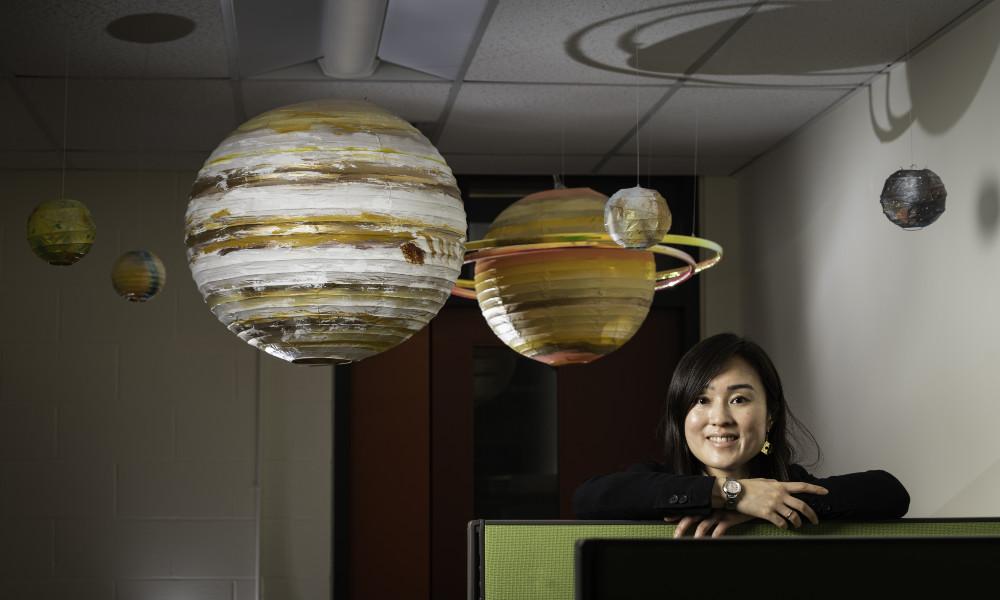Rochester will be among the prime viewing spots for the next total solar eclipse on April 8, 2024.
Mark your calendars for April 8, when Rochester will experience a total solar eclipse. With the city being among a handful of prime viewing spots throughout the country, the University of Rochester has day-of plans and activities underway. Check out our go-to online resource for everything you need to know ahead of the big day.
When is the next total solar eclipse? What time is the solar eclipse?
The next full solar eclipse is on April 8, 2024. The solar eclipse starts at 2:07 p.m. and ends at 4:33 p.m., with totality lasting from 3:20 p.m. to 3:23 p.m. In total, this phenomenon will last two hours and 26 minutes.
Can you look at a solar eclipse?
Reminder: Eclipses should only be viewed by watching a projected image of the sun or by using special glasses with protective lenses certified for safe eclipse viewing. Never look at the sun without proper eye protection; even a brief glance can cause permanent damage to your retinas.
Professor Jim Zavislan with the Institute of Optics has been scouting locations for people who want to safely photograph the 2024 eclipse. Viewing opportunities for the University community are being planned for the Eastman, Wilson, and Hajim Quadrangles on the River Campus.
- Learn more about protective eclipse eyeglasses, including where members of the University community can get a pair.

Q&A: What you need to know about solar eclipses
Dan Watson, a professor of physics and astronomy at Rochester, answers questions about the phenomenon of eclipses.
What is a solar eclipse? What causes an eclipse of the sun?
Watson: A solar eclipse is caused by the shadow of the moon, as the moon passes between you and the sun. The moon’s shadow has two parts: the umbra, which is the central region, and the penumbra, which is the outer region. People in the path of the umbra will see a total solar eclipse, whereas those on the area of Earth where the penumbra passes over will see a partial eclipse. Earth is bigger than the moon’s shadow, so where you’re standing on Earth makes a difference.
How often do total eclipses of the sun occur?
Watson: In any specific place on Earth, about once per 400 years on average.
Why don’t total eclipses of the sun happen more often?
Watson: They can only happen when the center of the moon lays between the Earth and the sun, along the straight line connecting that place on Earth and the center of the sun, and when the moon is relatively near Earth along its orbit. Because the moon’s orbit around the Earth is tipped slightly from the Earth’s orbit around the sun, this arrangement is rare. If the moon is close to its maximum distance from Earth when the eclipse occurs—so that it’s not as large on the sky as the sun is—we get an annular eclipse: a ring of sun surrounding the moon, as was the case on October 14, 2023, and which was as seen from parts of the western US, central America, and South America.
How do we know when eclipses will happen?
Watson: Astronomers have measured the orbits of the moon and planets, and the position and speed of each in their orbit, extremely accurately. With these data, and computers, we can predict with that same degree of accuracy where and when eclipses will occur.
What is it like during a total eclipse versus a partial eclipse?
Watson: During a total eclipse, it becomes like twilight for those two to three minutes of totality. The sun’s corona becomes visible as well as stars and planets, the temperature drops noticeably and animals respond with their normal nocturnal behaviors. Going from daylight to a period of relative darkness during the middle of the day is incredible to experience. During a partial eclipse, the sun will look like a crescent in the sky and the day will get a little darker, but it won’t be as striking as a total eclipse.
How excited should we be about the April 2024 total solar eclipse in Rochester?
Watson: Pretty excited! Although we might need to be concerned about the risk of the eclipse being clouded out. Historically, Rochester skies are clear 51 percent of the time on April 8 between 2 p.m. and 4:30 p.m. April 8, 2023, was a clear, sunny day locally.
Editor’s note: This story was originally published on October 10, 2023, ahead of the partial solar eclipse on October 14 of that year. It has been updated and republished with information about the 2024 eclipse.




